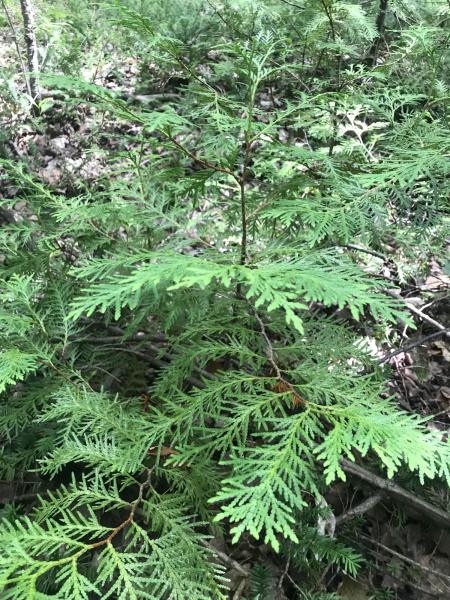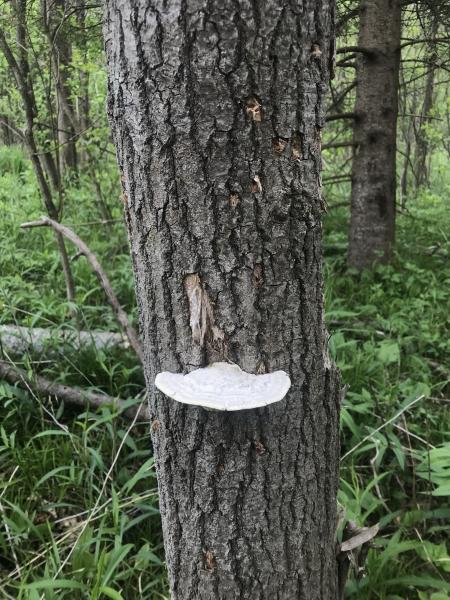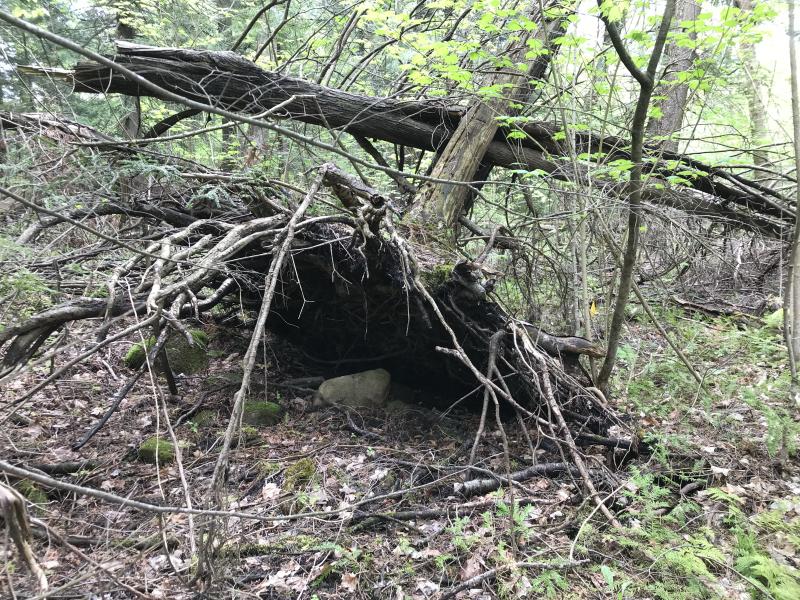Seneca Polytechnic, King Campus spans 284 ha, 190.7 hectares of which is a dedicated natural area. It is centered around Lake Seneca, also known as Eaton Hall Lake, which is a kettle lake that was formed by the melting of large, partially buried blocks of ice during the end of the last ice age (around 10,000 years ago). Kettle lakes are common in the vicinity, and the campus is part of the Eaton – Mary – Hackett wetland complex, which is a trio of kettle lakes situated within 750 meters of one another and interconnected by streams. The campus is crossed by a network of trails, including 4.5 kilometers integrated into the Oak Ridges trail system, which is a provincial trail spanning the Oak Ridges Moraine from Albion Hills to Northumberland Forest. Seneca Polytechnic College maintains an additional 14 kilometers of internal hiking trails, including the notable woodland passage. This 600-meter trail is accessible and features interpretive signs that offer insights into the site's natural and cultural heritage.
Seneca Polytechnic College, King Campus is situated within the Oak Ridges Moraine. The predominant vegetation cover is composed of deciduous sugar maple-beech and mixed sugar maple-hemlock forests. The dominant canopy trees in these forest types include sugar maple, American beech and hemlock, which grow in association with green ash, paper birch, yellow birch, cedar, black cherry, and basswood. Subcanopy trees and shrub species in these forest types include alternate dogwood, Canadian yew, mountain maple, and mountain ash. The understory is composed of sedges, wildflowers, such as blue cohosh, wild cucumber, Jack-in-the-pulpit, pepper root/toothwort, trout lily, Canada mayflower, downy Solomon's seal, zig-zag goldenrod, early meadow rue, violets, grapevines, Virginia creeper, large leaf aster, and white rattlesnake root. Fragile fern, Christmas fern, bracken, and wood fern are also common. However, forest understories, especially near trailheads, are impacted by the encroachment of exotic species such as periwinkle, garlic mustard and goutweed.
The north shore of the lake is covered by mixed swamps composed of hemlock, sugar maple, and cedar as the predominant tree cover, growing in association with beech and yellow birch. Here, subcanopy trees and shrubs include red maple, mountain maple, nannyberry, bittersweet nightshade, green ash, and alternate dogwood. The groundcover is composed of similar species as the sugar maple-beech and sugar maple-hemlock forests, with the addition of red trilliums, sensitive fern, jewelweed, oak fern, goldthread, sarsaparilla, and field horsetail.
Other ecosystem types on King campus include mature conifer plantations, located northeast of Lake Seneca and a young hybrid poplar plantation, located southwest of the lake. A forb meadow, dominated by goldenrods and asters, occurs west of the lake. Finally, Lake Seneca is fringed by marshes characterized by reed canary grass, sedges, cattails and thicket swamps composed of nannyberry and red osier dogwood.
Lake Seneca is situated just east of the Toronto Carrying Place, which is an Indigenous overland trail that has been utilized by several Indigenous nations, including the Huron-Wendat, Attawandaron/Neutral, Haudenosaunee, and Anishinaabe nations. Stone tools unearthed on the south shore of Lake Seneca provide archaeological evidence of continual Indigenous settlement around Lake Seneca dating back to the Archaic period (7500 CE to 500 CE). An Indigenous dugout canoe was unearthed near Lake Seneca by the Eaton family while they resided in Eaton Hall, suggesting continued Indigenous use of the Seneca Lake, perhaps in association with the Carrying Place, into post-contact times. This canoe, however, was unfortunately never officially registered as an archaeological or cultural heritage object.
King Township was transferred from the Mississaugas of the Credit First Nation to the British Crown in 1787 as part of the Toronto Purchase. From 1800 to 1859, the colonial government systematically surveyed the land, leading to the establishment of a grid-like road system. The British Crown granted land lots, typically 200 acres each, to settlers along these grids, encouraging European settlement, industry, land management, and agricultural practices in the vicinity. The first community to emerge near current day King Campus was Tinline Corner, which is now known as Eversley. Its development began in the early 1800s, but it never grew beyond the status of a hamlet and is currently a ghost town. Throughout the development of Upper Canada, Lake Seneca has been known by several other names including Lady Eaton Lake, Ferguson Lake, Lake Au-Large, Lake Jonda, Heart Lake, and Eaton Hall Lake. Most of these names reflect the Eaton family, who acquired the property that makes up current day King Campus in the 1920s. Eaton Hall, which is a Norman style castle that sits on the north shore of Lake Seneca, was constructed in 1937 for Lady Flora Eaton. During World War II, it served as a hospital for recovering soldiers in the navy. In 1971, the Eaton family sold their estate to Seneca College. Today, it serves as an inn and conference center, and has a reputation for being haunted.
Ontario Trails Council, King Trail - Seneca College: King Trail-Seneca College | Ontario Trails Council
Heritage Report, History of Seneca College King Campus: senecacollege.ca/about/masterplan/pdf/Final_Heritage_Report_2012.pdf
The Indigenous History of Tkaronto: https://guides.library.utoronto.ca/Toronto
| English | Latin | Kanienʼkéha | Anishinaabemowin |
|---|---|---|---|
| Red Maple | Acer rubrum | ka’takén:ra | zhiigmewanzh, zhiishiigimiiwanzh (-iik, plural) |
| Sugar Maple | Acer saccharum | wáhta’, ohwáhta | ininaatik, ininaatig (-oog, plural) |
| Wild Sarsaparilla | Aralia nudicaulis | tsyotere'se'kó:wa, yonekó:wa, tsyawenséhsha, otsyawénhsa | waaboos-odji-bik, waabooz jiibik |
| Jack-in-the-pulpit | Arisaema triphyllum | tyehnónhserote, kyehnónserote, kárhon, tsyorákares, tsorákares, kahnéhserote, okwá:rot nikarhonksherá:'a | zhaashaagomin |
| Yellow Birch | Betula alleghaniensis | tsyotsyó:ren | wiinizik (-oog, plural) |
| Paper birch | Betula papyrifera | watenakè:taron's, watenakè:taronhs | wiigwas (singular), wiigwaasaatig (plural), wiigwaasi-mitig |
| Blue Cohosh | Caulophyllum thalictroides | karhakón:ha, kahrhatakon | kwemshkiki, be'cigodji'bigak, bezhigojiibik, zhiigimewibag |
| Goldthread | Coptis trifolia | otsí:nekwar nikahtehrò:ten | zaawajiipkehns, zaawjiibkenhs |
| Alternate-leaf Dogwood | Cornus alternifolia | teyotsí:tsayen | moozwemizh, moozomizh, niibiishan miskwaabiimizhiig |
| Field Horsetail | Equisetum arvense | aweyó:ta | aanikawishkoons, zhiishiibinashk |
| Trout Lily | Erythronium americanum | skatsihstóhkonte | namegbagoniin |
| Large-leaved Aster | Eurybia macrophylla | teyonerahtawe'éhston, orón:ya yotiron’onhkóhare, iotsiron'onhkóhare oròn:ia, yako’tonhkwárhos onónhkwa, iako'tonhkwáhrhos onónhkwa | migiziwibag |
| American Beech | Fagus grandifolia | yotyentatí:wen | gawe’mic, sewe-miins |
| Green Ash | Fraxinus pennsylvanica | kaneróhon | emikwaansaak, aagimaak, bwoyaak |
| Spotted Jewelweed | Impatiens capensis | ietsi'erorókhstha, yetsi'erorókhstha | gzhiibosegaateaa, makikiibag, wesa’wasga’skonek, ozaawashkojiibik |
| Sensitive Fern | Onoclea sensibilis | tsyohtehrí:seron | a’nana’ganak, naanaaganashkoon |
| Virginia Creeper | Parthenocissus quinquefolia | kontiráthens | mnidoo- biimaakwad bebaamooded |
| Downy Solomon’s seal | Polygonatum pubescens | kítkit o'éta | agongseminan, agong’osiminan |
| Christmas Fern | Polystichum acrostichoides | tsyenhá:ken | (check this) |
| Black Cherry | Prunus serotina | é:ri, e:ri’kó:wa, tyotyò:ren | ookweminagaawanzh, ookweminan, ikwe'mic |
| Bracken Fern | Pteridium aquilinum | yetskaronhkwa'kó:wa | zhishkwedaansan, naanaaganashk (-oon), mzise miijim |
| Red Oak | Quercus rubra | karíhton | miskode-miizhmizh, mitig mewish (-iik plural) |
| Zig-zag Goldenrod | Solidago flexicaulis | otsí:nekwar niyotsi’tsyò:ten | ajidamoowaanow, waabanoominens/waabanoominensag, giizisso mashkiaki |
| New England Aster | Symphyotrichum novae-angliae | teyonerahtawe'éhston, yotsiron’onhkóhare orón:ya | waanisikensiwang |
| Dandelion | Taraxacum officinale | tekaronhyaká:nere | mindemoyanag, doodooshaaboojiibik, mindimooyenh, wezaawaaskwaneg |
| Canada Yew | Taxus canadensis | onn’tyón:ni | ne'bagandak |
| Early Meadow Rue | Thalictrum dioicum | otsi’tsyakérha | (check this) |
| White Cedar | Thuja occidentalis | onen’takwehtèn:tshera | giizhigaa'aandak, giizhik |
| Basswood | Tilia americana | ohóhsera | wiigobiish, wiigob, wiigobiig (plural) |
| Red Trillium | Trillium erectum | tsyonà:tsya onekwénhtara niyotsi’tsyò:ten, áhsen niioneráhtonte | moonigohn, ininiiwindibiigegan, ini'niwin'digige'gun |
| White Trillium | Trillium grandiflorum | tsyonatsyakén:ra niyotsi’tsyò:ten, tsyoná:tsik, áhsen niioneráhtonte | ininiiwindibiigegan, baashkindjibgwaan, baushkindjibgwaun, ini'niwin'digige'gun |
| Eastern Hemlock | Tsuga canadensis | onen’ta’ón:we | gaagaaimizh, baagoodag, mitg, gaagaagiwa/inzh |
| Nannyberry | Viburnum lentago | kaya (?) tará:kwi | (check this) |
| White Violet | Viola canadensis | tekonnyarotárhoks, tekonteniarotáhrhoks, tewatenyarotárhos | maskwi’widzhi’wiko’kok |
| Labrador Violet | Viola labradorica | tekonnyarotárhoks, tekonteniarotáhrhoks, tewatenyarotárhos | we-waawiyeyaa-bagak, wewaie’bagag |
| Wild Grape | Vitis riparia | o’nénhare | zhoominan, jo’minaga’wanj |
| Pepper root | Cardamine diphylla (Michx.) Alph. Wood | à:tsya | waasganjiibik |


